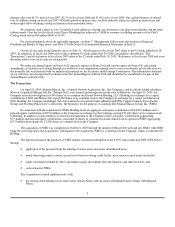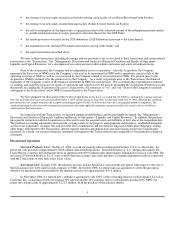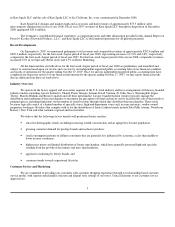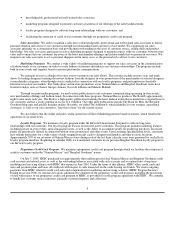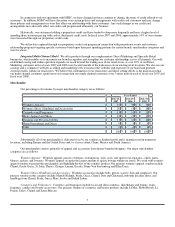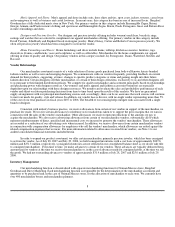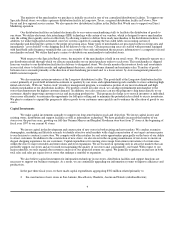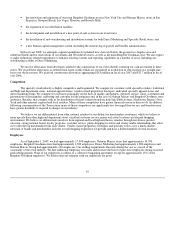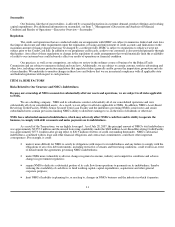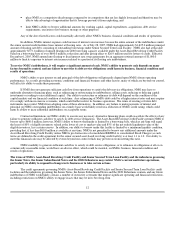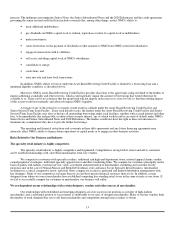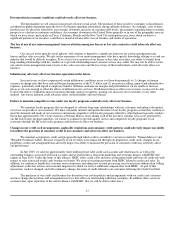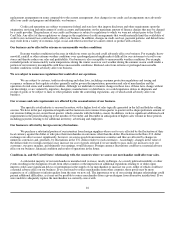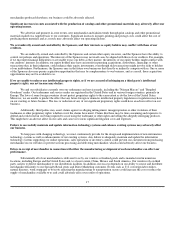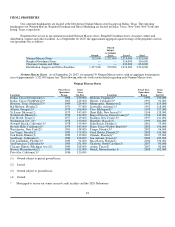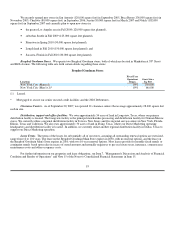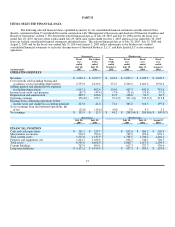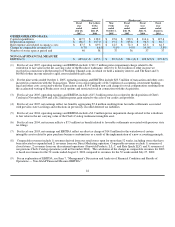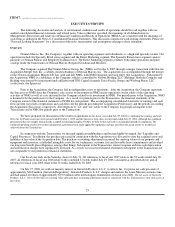Neiman Marcus 2006 Annual Report Download - page 16
Download and view the complete annual report
Please find page 16 of the 2006 Neiman Marcus annual report below. You can navigate through the pages in the report by either clicking on the pages listed below, or by using the keyword search tool below to find specific information within the annual report.
interests. The indentures governing the Senior Notes, the Senior Subordinated Notes and the 2028 Debentures and the credit agreements
governing the senior secured credit facilities include covenants that, among other things, restrict NMG's ability to:
• incur additional indebtedness;
• pay dividends on NMG's capital stock or redeem, repurchase or retire its capital stock or indebtedness;
• make investments;
• create restrictions on the payment of dividends or other amounts to NMG from NMG's restricted subsidiaries;
• engage in transactions with its affiliates;
• sell assets, including capital stock of NMG's subsidiaries;
• consolidate or merge;
• create liens; and
• enter into sale and lease back transactions.
In addition, NMG's ability to borrow under the Asset-Based Revolving Credit Facility is limited by a borrowing base and a
minimum liquidity condition, as described above.
Moreover, NMG's Asset-Based Revolving Credit Facility provides discretion to the agent bank acting on behalf of the lenders to
impose additional availability and other reserves, which could materially impair the amount of borrowings that would otherwise be
available to us. There can be no assurance that the agent bank will not impose such reserves or, were it to do so, that the resulting impact
of this action would not materially and adversely impair NMG's liquidity.
A breach of any of the restrictive covenants would result in a default under the Asset-Based Revolving Credit Facility and
Senior Secured Term Loan Facility. If any such default occurs, the lenders under the Asset-Based Revolving Credit Facility and Senior
Secured Term Loan Facility may elect to declare all outstanding borrowings under such facilities, together with accrued interest and other
fees, to be immediately due and payable, or enforce their security interest, any of which would result in an event of default under NMG's
Senior Notes and Senior Subordinated Notes and 2028 Debentures. The lenders would also have the right in these circumstances to
terminate any commitments they have to provide further borrowings.
The operating and financial restrictions and covenants in these debt agreements and any future financing agreements may
adversely affect NMG's ability to finance future operations or capital needs or to engage in other business activities.
Risks Related to Our Business and Industry
The specialty retail industry is highly competitive.
The specialty retail industry is highly competitive and fragmented. Competition is strong both to attract and sell to customers
and to establish relationships with, and obtain merchandise from, key vendors.
We compete for customers with specialty retailers, traditional and high-end department stores, national apparel chains, vendor-
owned proprietary boutiques, individual specialty apparel stores and direct marketing firms. We compete for customers principally on the
basis of quality and fashion, customer service, value, assortment and presentation of merchandise, marketing and customer loyalty
programs and, in the case of Neiman Marcus and Bergdorf Goodman, store ambiance. In our Specialty Retail business, merchandise
assortment is a critical competitive factor, and retail stores compete for exclusive, preferred and limited distribution arrangements with
key designers. Many of our competitors are larger than we are and have greater financial resources than we do. In addition, certain
designers from whom we source merchandise have established competing free-standing retail stores in the same vicinity as our stores. If
we fail to successfully compete for customers or merchandise, our business will suffer.
We are dependent on our relationships with certain designers, vendors and other sources of merchandise.
Our relationships with established and emerging designers are a key factor in our position as a retailer of high-fashion
merchandise, and a substantial portion of our revenues is attributable to our sales of designer merchandise. Many of our key vendors limit
the number of retail channels they use to sell their merchandise and competition among luxury retailers to obtain
13


